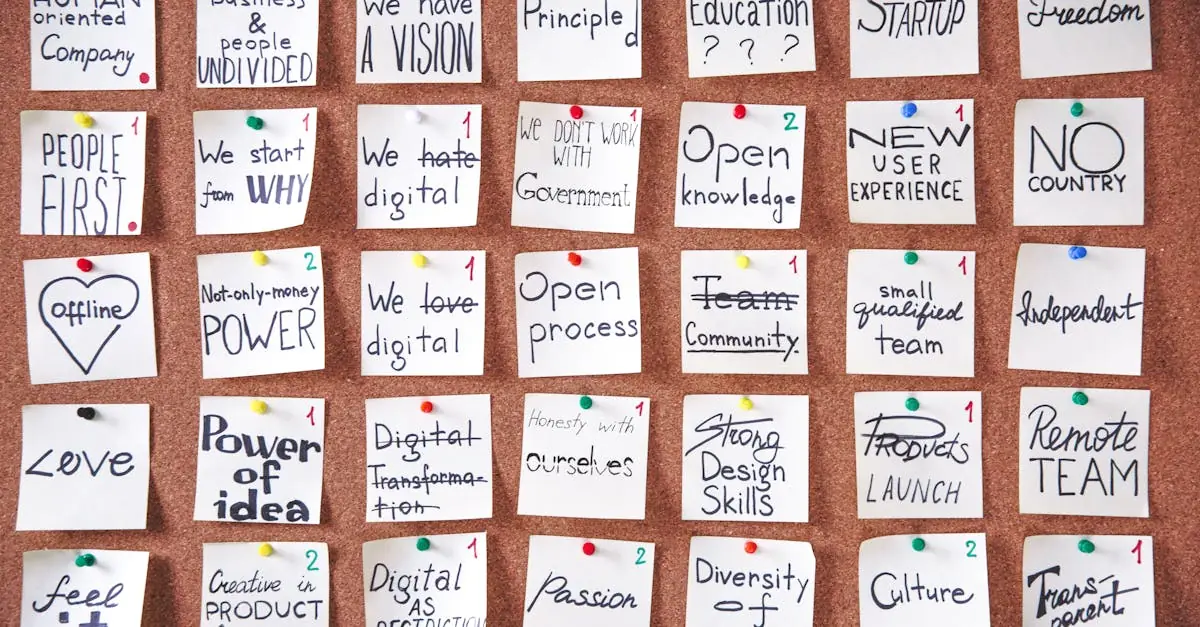Table of Contents
ToggleWhen it comes to design, Los Angeles is a playground of creativity and innovation. It’s where palm trees meet cutting-edge aesthetics, and every corner tells a story through its vibrant visuals. From sleek modern homes to eclectic art installations, LA design concepts redefine what it means to be stylish in the City of Angels.
Overview of LA Design Concepts
LA design concepts reflect a rich fusion of styles and influences. Modern architecture often stands alongside historic buildings, creating a vibrant architectural tapestry. Designers frequently draw inspiration from the city’s diverse cultural landscape, resulting in unique expressions of form and function.
Sustainability plays a key role in contemporary design practices. Many architects and designers incorporate eco-friendly materials, energy-efficient systems, and green spaces into their projects. This prioritization of environmental responsibility resonates with the city’s values and goals.
Collaborative spaces gain popularity, promoting interaction and creativity. Designers craft environments that encourage communication and connection among users. In many instances, these spaces adapt to evolving needs, ensuring functionality over time.
Art integrates seamlessly into design concepts across the city. Murals, sculptures, and installations transform public spaces, inviting community engagement. These artistic elements enhance the visual narrative of neighborhoods, showcasing local talent.
Technological innovation shapes many design strategies. Developers use cutting-edge tools and techniques to create smart homes and commercial buildings. Enhancing user experience through technology integrates seamlessly into the overall design philosophy.
Trends in color and material reflect LA’s vibrant culture and climate. Bright colors and natural textures dominate public and private spaces, capturing the essence of Southern California living. Designers emphasize a balance between aesthetics and functionality, creating inviting environments.
Ultimately, LA design concepts embody adaptability and creativity. Each project contributes to a collective vision that continuously evolves, highlighting the city’s role as a design leader. Embracing both the past and present, these concepts solidify LA’s position at the intersection of innovation and tradition.
Key Features of LA Design Concepts
LA design concepts embrace creativity and innovation, showcasing unique features that define the city’s architectural landscape.
Innovative Use of Space
Innovative designs often prioritize flexible layouts. Architects maximize functionality while minimizing waste. Open floor plans encourage collaboration and interaction, reflecting the city’s vibrant culture. Multi-purpose spaces emerge, allowing for work, leisure, and social activities in a single area. Panels or movable walls create dynamic environments, adapting to the needs of users. This approach fuels creativity, fostering a sense of community within residential and commercial spaces.
Integration of Nature
Nature plays a significant role in LA design concepts. Designers frequently incorporate green spaces, promoting well-being and connection to the outdoors. Concepts like living walls and rooftop gardens enhance urban areas, filtering air and improving aesthetics. Natural light floods interiors, creating bright, inviting atmospheres. The use of sustainable materials further strengthens this connection, blending indoor and outdoor environments seamlessly. This integration reflects a commitment to environmental responsibility, enhancing the quality of life for residents.
Popular Styles Within LA Design Concepts
LA design concepts showcase various popular styles, each reflecting the city’s unique charm and creative energy. Key styles include Mid-Century Modern, Minimalism, and the Bohemian Influence.
Mid-Century Modern
Mid-Century Modern design emerged in the 1940s and thrives in Los Angeles homes and commercial spaces. Clean lines and organic forms define this style, emphasizing functionality alongside aesthetic appeal. Large windows create a connection with nature, bringing the outdoors inside. Elements such as open floor plans foster a sense of spaciousness, inviting natural light to illuminate interiors. Iconic figures like Richard Neutra and Charles and Ray Eames popularized this movement, infusing it with a timeless quality. This style offers a legacy that continues to inspire contemporary designers.
Minimalism
Minimalism takes a straightforward approach, stripping design down to its essential elements. The emphasis lies on simplicity, functionality, and clarity, making it prevalent in many LA spaces. Neutral color palettes, clean lines, and uncluttered environments contribute to a serene atmosphere. Furniture often prioritizes understated elegance, allowing art pieces to stand out. The focus on quality over quantity promotes deliberate choices that resonate with sustainability. Consequently, this design philosophy aligns with Los Angeles’ drive for conscious living.
Bohemian Influence
Bohemian Influence introduces a vibrant, eclectic spirit to LA’s design landscape. Layered textiles, bold patterns, and rich colors characterize this style, fostering warmth and individuality. Artisanal pieces and vintage finds enhance interiors, showcasing unique stories and experiences. Greenery, including potted plants and hanging foliage, promotes a connection to nature that intertwines with the urban lifestyle. This embracing of diversity and creativity reflects the essence of Los Angeles, making it a beloved choice among many residents.
Impact of LA Design Concepts on Architecture
LA design concepts significantly shape contemporary architecture through their rich cultural influences. Architects embrace a diverse palette of styles, balancing modern aesthetics with historical context. Sustainably designed buildings reflect a commitment to environmental consciousness, incorporating eco-friendly materials and energy-efficient systems. This alignment with nature enhances both form and function, resonating with the city’s values.
The emphasis on collaborative spaces introduces a new era of interaction among residents. Spaces designed for versatility foster connections and engagement, promoting creativity within the community. Integration of art into architecture encourages vibrant public spaces, inviting participation and enhancing the urban experience.
Innovative technology transforms architectural practices in Los Angeles. Smart homes, equipped with advanced systems, streamline daily life while showcasing cutting-edge design. The trends in color and material usage highlight LA’s vibrant identity, using bold hues and natural textures that reflect Southern California’s unique lifestyle.
Key characteristics of LA’s architectural impact include the innovative use of space. Flexible layouts adapt to various activities, allowing residents to transition seamlessly from work to leisure. Nature plays a crucial role in this design philosophy, with green spaces, living walls, and rooftop gardens becoming pivotal elements of urban fabric. Such integration improves well-being and nurtures community ties.
Exploring popular styles further reveals the essence of LA architecture. Mid-Century Modern’s clean lines connect spaces to nature and functionality. Minimalism’s simplicity fosters tranquility, aligning with the desire for intentional living. In contrast, the Bohemian Influence showcases vibrant textiles and eclectic decor, celebrating individuality and creativity.
Ultimately, LA design concepts drive architectural innovation while cultivating a dynamic urban landscape that evolves consistently.
Future Trends in LA Design Concepts
Sustainability continues to shape LA design concepts as eco-conscious approaches become mainstream. Architects readily incorporate renewable materials and energy-efficient technologies into their projects, ensuring alignment with the city’s environmental ethos. Emerging trends highlight a focus on biophilic design, where connecting indoor spaces with nature enhances well-being and encourages mindfulness.
Integration of smart technology defines future developments in LA. Developers increasingly utilize automation and IoT devices to create responsive environments that simplify daily living. Enhanced connectivity prioritizes user experience, making homes more adaptable to residents’ needs.
Collaboration remains central to evolving design concepts, fostering creative ecosystems. Spaces designed for interaction promote community engagement, transforming traditional structures into dynamic hubs. Community-driven projects empower residents to participate in shaping their environments, making inclusivity a priority.
Color trends are embracing bold palettes that resonate with the vibrancy of Los Angeles culture. Bright hues and nature-inspired tones create lively atmospheres, helping spaces reflect local identity. Texture also plays a critical role, with designers blending traditional and modern elements to craft inviting interiors.
Adaptive reuse gains traction among architects. Repurposing historic buildings not only preserves cultural heritage but also encapsulates sustainable practices. This trend fosters awareness of the past while addressing contemporary needs, creating a dialogue between history and modernity.
Flexibility in space design supports multifunctional living. Open layouts provide versatility for various activities, catering to diverse lifestyles. Outdoor spaces also trend upward, with rooftop gardens and patios offering serene retreats amidst urban life.
The fusion of artistic expression and practical design evolves, making public art installations integral to urban planning. Creative interventions transform ordinary spaces, enriching community narratives through visual storytelling. As these trends unfold, LA’s design concepts continue to redefine urban landscapes, embracing innovation while respecting tradition.
LA design concepts are a testament to the city’s creative spirit and innovative mindset. They seamlessly blend modern aesthetics with historical context while prioritizing sustainability and community engagement. As architects and designers continue to explore new materials and technologies, the future of LA’s architectural landscape looks promising.
The emphasis on versatile spaces and the integration of nature not only enhance urban living but also reflect a commitment to well-being. With a focus on collaboration and artistic expression, LA will continue to inspire and redefine design standards, establishing itself as a leader in architectural innovation. The vibrant culture and dynamic environment ensure that LA’s design concepts will evolve, capturing the essence of this unique city.




